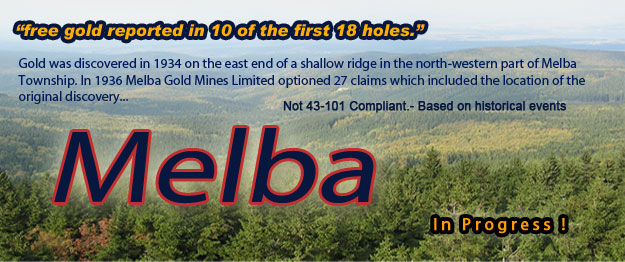The Melba Property

Gold was first discovered in 1934 on the east end of a shallow ridge in the north-western part of Melba Township. In 1936 Melba Gold Mines Limited optioned 27 claims which included the location of the original discovery.
In 1939 Teck-Hughes Mines Limited channelled and took a 4-ton bulk sample over a length of 60 feet on the Blue Vein during a sixty day option. The channel sample gave 0.327 oz. gold per ton over 4.5 feet and the bulk sample gave 0.210 oz. gold per ton over 4.5 feet.
George E. Moody, graduate of University of Alberta in mining engineering 1931, and a Professional Engineer Province of Québec, Fellow of the Geological Association of Canada filed a report dated April 11, 1961 and filed a further report dated November 20, 1962.
The report based on surface and underground examination on Nobember 13, 1959.
• The direct supervision of the recent diamond drilling programme:
• The detailed mapping of the outcrop area in the vicinity of the shaft as well as a study of
• Data on file in the Pitchvein Mine's office regarding work by former operators as well as that done by Pitchvein Mines Limited
There are two dominant regional structural features.
1. The Porcupine - Destor Fault system which passes about 9 miles north of the Pitchvein property. With this lengthy structure are associated, in the Porcupine camp, the following producers, Pamour, Hallnor, Broulan Reef and Dome Mines; in Hislop Township the Ross Mine (Hollinger) and in Québec the Beattie and Duquesne Mines. Many lesser gold deposits lie between or beyond thos mentioned.
2. The Kirkland Lake - Larder Lake Fault System. With this structure the mines of Kirkland Lake, Upper Canada and Kerr - Addison are associated as are other producers and other lesser gold deposits.
These two dominant structures tended to follow regional synclinal basins, usually represented by a series of sedimentary rocks. The gold bearing ore bodies strung along these two structures are believed to be related to Algoman porohyries which intruded along the main or subsidiary faults.
The sedimentary rocks occuring on the Pitchvein property are thought to represent another infolded structure which has been the loci for strong faulting and into which porphyries with their associated gold-bearing veins have intruded. In this Pitchvein structure closesly resembles the "Kirkland Lake" and the "Porcupine - Destor" structures and their associated gold deposits.
Local Geology:
Most of the claims are low and overburdened. Outcrops are limited. The only government map is the "Black River Sheet" No. 30C published in 1921. It is a reconnaissance map only and shows Melba Township to be underlain mainly by basaltic lavas.
The main outcrop area on the property is on Claim L 59506 and it is here that the gold discovery was made, surface work was done and the shaft sunk.
Source: http://www.nordexexplosives.com/index.php?nav=96&page=105
Please e-mail your resume and cover letter to careers@nordexexplosives.com or contact us now for more information